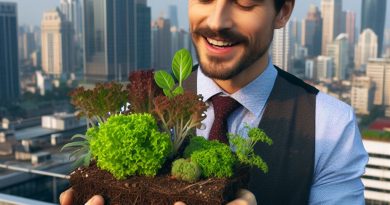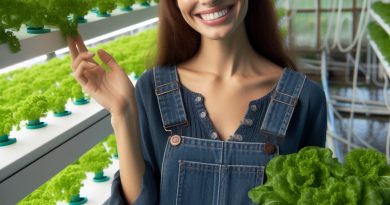Tiny Farming: Maximize Your Balcony’s Yield
Last Updated on March 2, 2024
Introduction
The implementation of Tiny Farming Balcony Yield plays a vital role in ensuring food security and promoting sustainability within urban environments.
Tiny farming refers to growing food in small spaces and offers numerous advantages.
Maximizing yield on a balcony requires strategic planning and specific techniques.
Choose suitable crops like herbs, leafy greens, and compact vegetables for balcony farming.
Optimize space by using vertical gardening techniques such as trellises, hanging baskets, and wall planters.
Ensure proper sunlight, moisture, and drainage to promote healthy plant growth on the balcony.
Use organic fertilizers and compost to provide essential nutrients to plants.
Implement pest control measures like companion planting, natural repellents, and physical barriers.
Regularly water and prune plants to maintain optimal health and productivity.
Harvest crops in a timely manner to encourage continuous production and prevent overcrowding.
Extend the growing season by utilizing season extenders like cold frames, row covers, and greenhouse kits.
Collect and save seeds from successful plants to save money and have a sustainable source for future cultivation.
Engage in community gardening initiatives to learn from experienced gardeners and share resources.
Enjoy the satisfaction of growing your own food, connecting with nature, and promoting a greener urban environment.
Urban dwellers can contribute to food security and reduce their carbon footprint through tiny farming on balconies.
In conclusion, tiny farming on balconies is a practical and rewarding way to maximize food production in urban areas.
By implementing proper techniques and utilizing available space, individuals can enjoy fresh produce from their own homes.
Embrace the potential of balcony farming and join the growing movement towards self-sufficiency and sustainability.
Assessing your balcony
Evaluating available space
Creating a successful tiny farm on your balcony begins with assessing the available space you have.
Consider the dimensions and layout of your balcony to determine how much room you can dedicate to your farming project.
- Measure the dimensions of your balcony.
- Take note of any obstructions such as railings, furniture, or other decorative items that may limit your available space.
- Consider the clearance height for taller plants or trellises that you may want to incorporate into your balcony farm.
- Determine if any additional shelving or vertical hanging options are feasible to maximize your space utilization.
Determining sunlight exposure
Sunlight is a crucial factor for the success of any farming endeavor.
It is important to understand the amount and duration of sunlight exposure your balcony receives throughout the day.
- Observe the direction your balcony faces and note the hours of direct sunlight it receives.
- Take into account any nearby buildings or structures that may cast shadows on your balcony, reducing the sunlight exposure.
- Consider the seasonal changes in sunlight intensity and adjust your farming plans accordingly.
Considering weight and load-bearing capacity
Before transforming your balcony into a thriving farm, it is imperative to ensure that it can bear the weight of the containers, soil, plants, and additional equipment.
- Research your balcony’s load-bearing capacity to determine how much weight it can safely support.
- Take into account the weight of the pots, containers, soil, and plants you plan to have.
- Distribute the weight evenly across your balcony to avoid any excessive stress on specific areas.
- Consult with a professional if you are unsure about your balcony’s load-bearing capacity or need guidance on reinforcing it.
Selecting suitable pots or containers
Choosing the right pots or containers is vital for the health and growth of your plants.
Consider the specific needs of your chosen crops and the available space on your balcony.
- Look for pots or containers that are appropriate in size for the plants you intend to grow.
- Ensure that the chosen containers have good drainage to avoid waterlogging.
- Consider the materials of the pots or containers – lightweight options may be more suitable for balcony farming.
- Opt for self-watering containers or those with reservoirs if you have limited access to water or face time constraints.
By thoroughly assessing your balcony’s potential, evaluating available space, sunlight exposure, weight capacity, and selecting suitable pots or containers, you will be well-prepared to embark on your tiny farming journey.
Read: Space-Saving Farm: Hydroponic Techniques
Choosing the right plants
Types of plants suitable for balcony farming
When choosing plants for your balcony, consider those that are well-suited to container gardening.
Herbs like basil, parsley, and mint are excellent choices as they require minimal space and can thrive in pots.
Salad greens such as lettuce and spinach are also ideal for balcony farming.
Considering the climate and season
Before selecting plants, it’s essential to consider the climate and season of your region.
Some plants prefer cooler temperatures, while others thrive in warmer weather.
Research the specific needs of the plants you’re interested in and ensure they align with your local climate and the current season.
Selecting plants based on available space and sunlight
Take into account the available space on your balcony and the amount of sunlight it receives each day.
Some plants require full sunlight, while others can tolerate shade.
Choose plants that match the conditions of your balcony to maximize their growth and yield.
Identifying space-efficient varieties
To make the most of your limited balcony space, look for space-efficient plant varieties.
Compact and dwarf varieties of vegetables and fruits, such as cherry tomatoes, zucchini, and peppers, are excellent choices.
These plants take up less space but still offer a bountiful harvest.
Some space-saving plants that thrive in containers
- Cherry tomatoes: Compact varieties like ‘Tiny Tim’ or ‘Patio Princess’ are perfect for balcony farming. They produce small, flavorful fruits and can be grown in hanging baskets or pots.
- Salad greens: Lettuce, spinach, and arugula can be grown in shallow containers or window boxes. Harvest the outer leaves as needed, and the plants will continue to produce throughout the season.
- Herbs: Basil, parsley, mint, and chives are versatile and can thrive in small pots. They can be used to enhance the flavor of various dishes and are a must-have for any balcony garden.
- Peppers: Dwarf pepper varieties, like ‘Mini Bell’ or ‘Lunchbox,’ are suitable for container gardening. They produce abundant, colorful fruits that add a spicy kick to your meals.
- Strawberries: Hanging baskets or vertical planters are perfect for growing strawberries. They add a pop of color to your balcony while providing a tasty treat.
Remember to provide appropriate care for your plants, including regular watering and fertilization.
Monitor their growth and make adjustments as necessary to ensure they thrive in the balcony environment.
In conclusion, choosing the right plants for your balcony farming venture is crucial for maximizing your yield.
Consider plants suitable for container gardening, take into account the climate and season, select plants based on available space and sunlight, and opt for space-efficient varieties.
By making these informed decisions, you can create a thriving and productive balcony garden.
Read: Urban Oasis: Aquaponic Gardening Basics
Soil and Fertilization
Selecting appropriate soil mixtures
- Determine the needs of your plants and choose a soil mixture that meets those requirements.
- Look for a soil mix that is lightweight, well-draining, and nutrient-rich.
- Consider using a combination of potting soil, compost, vermiculite, and perlite for optimal results.
- Avoid using garden soil or topsoil alone, as they may be too heavy and compact for container gardening.
- Check for pH levels in the soil mix to ensure it is suitable for the plants you want to grow.
Understanding fertilizers and their application
- Familiarize yourself with different types of fertilizers, such as organic, synthetic, and slow-release.
- Read the instructions on the fertilizer packaging to understand the recommended application rates.
- Apply fertilizers sparingly to prevent nutrient burn or overfertilization, which can harm your plants.
- Consider using a balanced fertilizer with equal amounts of nitrogen, phosphorus, and potassium for overall plant health.
- Follow a regular fertilization schedule based on the specific needs of your plants.
Organic and sustainable options
- Choose organic fertilizers that are derived from natural sources, such as compost, worm castings, or seaweed extracts.
- Organic fertilizers release nutrients slowly, promoting long-term soil fertility and reducing the risk of nutrient leaching.
- Consider making your own compost using kitchen scraps, yard waste, and other organic materials for a sustainable option.
- Explore sustainable practices like crop rotation, intercropping, and companion planting, which can improve soil health without relying heavily on fertilizers.
- Research eco-friendly alternatives for pest control and weed management to further reduce your environmental impact.
Ensuring proper drainage and moisture retention
- Choose containers with drainage holes to prevent waterlogged soil and root rot.
- Place a layer of gravel or broken pottery at the bottom of the container to improve drainage.
- Use a well-draining soil mix to ensure excess water can easily flow through the container.
- Monitor the moisture level of your soil regularly and water accordingly to prevent drought or overhydration.
- Consider using mulch or a layer of organic matter on top of the soil to improve moisture retention and reduce evaporation.
In general, soil quality plays a crucial role in maximizing your balcony’s yield.
By selecting the right soil mixtures, understanding fertilizers, exploring organic options, and ensuring proper drainage and moisture retention, you can create an optimal environment for your plants to thrive. Happy tiny farming!
Read: From Water to Table: Hydroponic Growing
Balcony garden layout
A balcony garden can be a beautiful and productive space with the right layout.
Here are some tips:
Designing for vertical gardening
- Maximize your balcony’s space by utilizing vertical gardening techniques.
- Consider installing wall-mounted planters or using a shelving system to create vertical layers.
- Choose compact plants that can thrive in smaller spaces.
- Use trellises or mesh netting to support climbing plants like tomatoes or beans.
Utilizing hanging planters or trellises
- Hanging planters can add depth and visual interest to your balcony garden.
- Hang them from the ceiling or attach them to railings or walls.
- Choose lightweight containers and secure them properly to avoid accidents.
- Consider using a trellis system to support vining plants like cucumbers or melons.
Arranging plants for optimal sunlight exposure
- Observe your balcony’s sunlight patterns to determine the best placement for your plants.
- Group sun-loving plants together in areas that receive the most sunlight.
- Place shade-tolerant plants in areas that receive less direct sunlight.
- Avoid placing tall plants in a way that they shade smaller ones.
Incorporating companion planting techniques
- Companion planting is a technique where certain plants are grown together for mutual benefit.
- Planting herbs like basil or mint near vegetables can help repel pests.
- Growing flowers like marigolds can attract beneficial insects to pollinate your plants.
- Consider the compatibility of plants when arranging them to maximize their potential.
With a well-planned layout, you can make the most of your balcony garden’s space and increase its yield.
Read: Organic Garden Pest Identification Guide

Watering and Maintenance
Achieving optimal watering and maintenance practices is essential for maximizing the yield of your balcony farm.
By establishing a proper routine and monitoring soil moisture levels, you can ensure the health and productivity of your plants.
Establishing a Watering Routine
Maintaining a consistent watering schedule is crucial for the success of your tiny farm.
Create a routine that works best for your balcony’s environment and the specific needs of your plants.
- Water your plants at the same time each day to provide them with a steady supply of moisture.
- Consider the weather conditions and adjust your watering routine accordingly. Plants may need more water during hot, dry periods.
- Ensure proper drainage by using well-draining pots and adding drainage holes to avoid overwatering.
Monitoring Soil Moisture Levels
Regularly checking the moisture content of your soil allows you to make informed decisions about watering.
Proper monitoring ensures your plants receive the right amount of water.
- Use a moisture meter or your fingers to assess the moisture level of the soil.
- Water your plants when the top inch of soil feels dry. This helps prevent both overwatering and underwatering.
- Adjust the frequency and amount of watering based on the specific requirements of each plant species.
Recognizing Signs of Overwatering or Underwatering
Learning to recognize the signs of overwatering or underwatering is critical to maintaining the health of your plants and preventing damage to your balcony farm.
- Overwatering may cause yellowing leaves, root rot, and the presence of fungus or mold.
- Underwatering often leads to wilting, dry soil, and stunted growth.
- Regularly inspect your plants for these signs and adjust your watering routine accordingly.
Pest Control and Disease Prevention Methods
Ensuring your tiny farm remains pest-free and disease-resistant is vital for maximizing yield.
Implement preventive measures to protect your plants from common pests and diseases.
- Regularly inspect your plants for signs of pests such as aphids, mites, or snails.
- Introduce natural predators like ladybugs or use organic pest control methods if necessary.
- Maintain good air circulation and avoid overcrowding to minimize the risk of diseases.
- Remove any infected or diseased plants immediately to prevent the spread of illness.
- Consider using organic fungicides or neem oil as preventive measures against fungal diseases.
By following these watering and maintenance practices, you can ensure the thriving growth and abundant yield of your balcony farm.
Regular monitoring and proactive care will lead to a successful and productive tiny farming experience.
Gain More Insights: Container Gardens: Year-Round Tips
Harvesting and extending the growing season
Harvesting at the right time
- Observe the plants closely and harvest when they are at their peak ripeness.
- Check the fruit or vegetable for color, firmness, and taste to determine if it’s ready.
- Harvesting at the right time ensures maximum flavor and nutrient content.
Promoting regrowth and continuous yields
- Cut or harvest plants in a way that encourages regrowth and continuous production.
- For leafy greens like lettuce, harvest the outer leaves first and leave the inner ones to grow.
- By leaving some of the plant intact, you allow it to regrow and provide more harvests.
Utilizing season-extending techniques
- Use covers such as row covers or cloches to protect plants from early frost or cold temperatures.
- Shelters such as mini-greenhouses or cold frames can extend the growing season by providing warmth.
- These techniques create a microclimate for your plants and help them thrive in colder conditions.
Maximizing balcony space during the offseason
- Use vertical gardening techniques to make the most out of limited balcony space.
- Install trellises or vertical planters to grow climbing plants like tomatoes or cucumbers.
- Consider growing herbs or microgreens indoors during the offseason when balcony space is limited.
- Optimize your balcony layout by using shelves or hanging planters to maximize space utilization.
- Utilize underutilized spaces such as corners or railings to grow small plants or herbs.
In a nutshell, harvesting at the right time, promoting regrowth, utilizing season-extending techniques, and maximizing balcony space during the offseason can help you maximize your balcony’s yield.
By following these practices, you can enjoy a continuous and abundant harvest throughout the growing season.
Conclusion
Tiny farming on balconies offers numerous benefits, from saving money to living sustainably.
It provides fresh, nutrient-dense foods close at hand while reducing your environmental footprint and food waste.
Plus, it’s a rewarding hobby that brings nature into your home.
If you haven’t started balcony farming yet, now’s the perfect time!
With proper planning, smart container choices, suitable plants, and dedicated care, you can transform your outdoor space into an edible oasis.
Remember, even small efforts make a difference.
Ensure success by regularly monitoring plants, rotating crops, using vertical space efficiently, and engaging with your local gardening community.
Stay patient, learn from failures, and celebrate small victories on your tiny farming journey.
We’d love to see your balcony farming progress and harvest photos!
Share your experiences on our community forum or tag us on social media using


